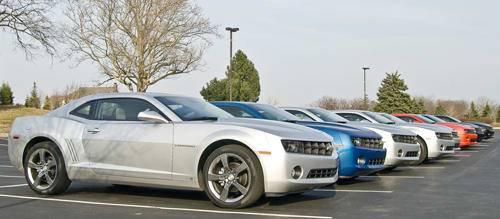Domestic-Parts Content: Where the Automakers Stand


Cars.com’s annual American-Made Index rates cars built and bought in the U.S. The percentage of domestic content used in each car plays a major role in the index; we use the domestic-parts content rating that’s been required on new-car labels since the mid-1990s. The top-placing Toyota Camry, for example, has an 80% domestic-parts content rating for the 2010 model. But where do automakers’ entire lineups rank against each other in terms of their vehicles’ domestic-parts content, particularly when you weight the cars by how many they sell?
It’s no simple task to determine — you’ll see some wrinkles below — but we took our best shot. Weighted for sales, here’s how the big players measure up in domestic-parts content:
GM: 69%
Ford Motor Co.: 64%
Chrysler Corp.: 60%
Honda/Acura: 58%
Toyota/Lexus/Scion: 44%
Nissan/Infiniti: 31%
Mitsubishi: 25%
Subaru: 20%
Mercedes-Benz: 16%
Suzuki: 12%
Mazda: 11%
Volkswagen/Audi: 9%
BMW/Mini: 5%
Jaguar/Land Rover: 3%
Porsche: 3%
General Motors, which fielded three models in this year’s AMI, leads the pack at 69%. Credit strong sellers like the Chevy Malibu and Pontiac G6 (both 80%). While we disqualified the G6 in the AMI — as it’s being discontinued along with the rest of Pontiac — we didn’t for this list because this one is only concerned with the overall level of domestic parts that automakers’ cars and trucks use. Ford comes in second, even though Volvo (which it owns) has a lineup with minimal domestic-parts content. That drags its parent down roughly 2 percentage points. Chrysler rounds out the top three at 60%. Interestingly, Honda ranks the highest among Japanese automakers, thanks in part to heavy-hitters like the Odyssey (80%), Accord (65%) and Pilot (70%). Toyota landed a record four cars on the AMI, but its aggregate parts content remains a less-impressive 44%. Why? Despite popular cars like the Camry (75% for 2009 model, 80% for 2010), Tundra (80%) and Sienna (85%), the automaker has more than a dozen models with domestic-parts content ratings south of 30%.
The National Highway Traffic Safety Administration publishes a list each model year for domestic-parts content. To see where car companies stand, we weighted NHTSA’s 2009 domestic-parts content ratings against each model’s year-to-date sales through June. You’ll note that NHTSA doesn’t report every brand out there: A handful of brands, from Hyundai/Kia to Smart, haven’t yet been reported. We asked NHTSA why, and we’ll let you know when we get a response.
We aren’t the first group to compile this sort of ranking. The Automotive Trade Policy Council, a Washington, D.C.-based organization that represents the Detroit Three automakers, compiled aggregate domestic-parts content ratings in 2006. Back then, ATPC found Detroit automakers had sales-weighted parts content of 76%, while Japanese companies came to 48%.
Keep these figures in mind as you read the American-Made Index. The Camry may be the most American car this year, but when you’re looking at the domestic-parts content of an entire automaker, Detroit still comes out on top.

Former Assistant Managing Editor-News Kelsey Mays likes quality, reliability, safety and practicality. But he also likes a fair price.
Featured stories




